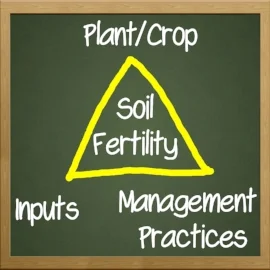Four Things Your Agronomist Should Know About You
I’ve been doing a lot of farm visits lately. I wish I could get to everyone I work with and meet them one on one and walk all their fields. The reality is, there is only one of me. So, until I can convince the boss to let me hire another one of me, I will continue to take on new clients in other states and do my best to build a relationship with them with the aid of Skype, Zoom, email, texting, pictures, etc. I’m grateful technology has made working remotely with farmers possible, but nothing can replace seeing it with my own eyes.
As I was driving home from a farm visit last night, I got to thinking…
What can I, or any agronomist do to make a relationship work with a farmer whether I can be on the farm regularly or not?
It dawned on me-
I need all the information I can get about every aspect of their farm, their fields, and their crops.
The farm I was driving home from is in Maryland. I spent a couple of hours walking their fields, talking with them, and answering questions. As we were wrapping the tour up during a short walk to my car I learned more about what they had done in the past seven years to two of their fields, then I had when we were out in them.
I work with a farmer in New York. I can tell what field they are talking about without even knowing the assigned field name or looking at the map. I know their fields by the way they describe what is going on, what the challenges are, what the crops are, and so on. I know what equipment they have and what fertilizer recommendations I can make based on it. I know all of this because I have spent five years asking questions, keeping notes, and listening to every detail.
When I work with a farmer, I am in a constant state of getting to know them and their farm or as I like to call it -dating.
Not actually ‘dating,’ like we’re a couple. But dating in the sense that I have to be genuinely interested in their farm. I also have to take an interest in them as a person to get all the information I need to help them be or stay the farmer they want to be.
So, I broke the information down into four things your agronomist should know about you to successfully build a relationship that will help elevate you as a farmer. But just like any other relationship, it takes time and a desire to want the relationship to work. To be honest, this probably won’t be a complete list either, each farm and farmer are unique, and what I need to know about one, I might not need to know about another. These are good starting points to work from.
I want to know…
1. The Past- Field History
Previous crops
Previous amendments/fertilizers
Previous insecticides/herbicides/fungicides
Previous soil/tissue or other analytical testing results
Previous crop failures/yield results
2. Your Present – Current Field/Farm Conditions
Current field/crop conditions
Current amendments/fertilizers applied to that field
Current challenges/concerns
Current yield goals/expectations for that crop
Available equipment/labor/resources
3..Your Future – Next Intended Crop
Crop rotation plan
Crop yield goals
Any future testing, i.e., soil sampling
4. Your Farming Style – Management Practices
This list is endless
Farming style may sound funny but, hear me out. I work with every type of farmer imaginable. Each one has their vision, i.e. goals or expectations, for their farm and how they want to achieve them. Each one has its own set of limitations or resources available. I have to know and understand all of that to give advice and make recommendations that apply to that farm and farmer, not the other guy down the road doing things differently. This includes information as to
Do you farm certified organic, certified naturally grown, bio-dynamically, etc.?
Any grazing or tillage methods, etc.
The time commitment you’re willing, can, or want to make to farming
I’ve said before; agronomy is science applied practically. All the science and product knowledge mean nothing if a farmer can’t use it. The only way I can do that is to get to know how and why you are farming. Like as if we are dating, and I am always asking questions to get to know you.












